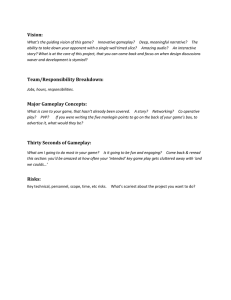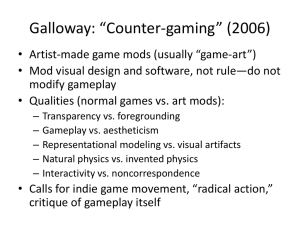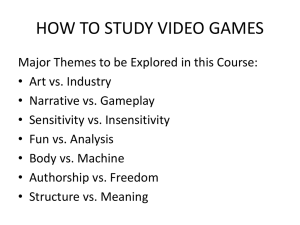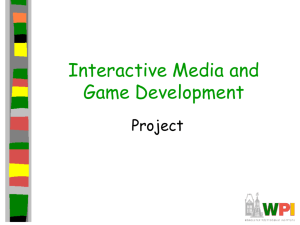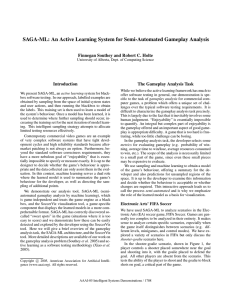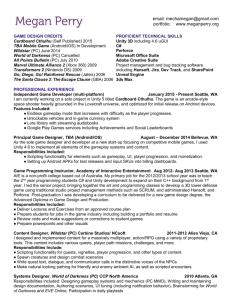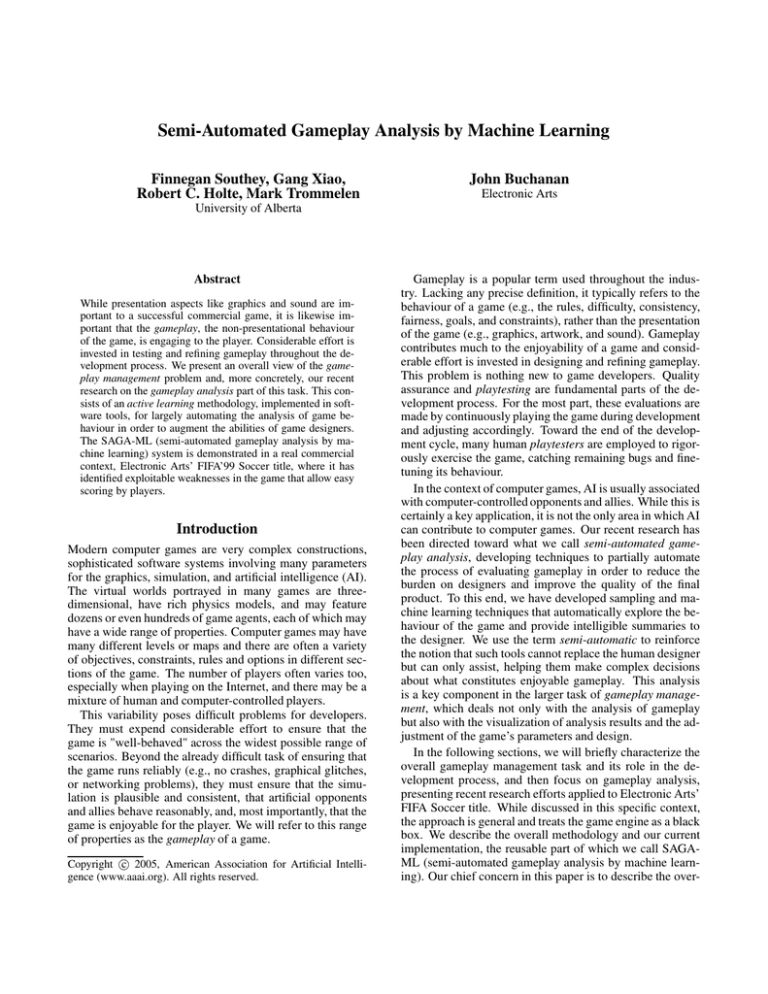
Semi-Automated Gameplay Analysis by Machine Learning
Finnegan Southey, Gang Xiao,
Robert C. Holte, Mark Trommelen
University of Alberta
Abstract
While presentation aspects like graphics and sound are important to a successful commercial game, it is likewise important that the gameplay, the non-presentational behaviour
of the game, is engaging to the player. Considerable effort is
invested in testing and refining gameplay throughout the development process. We present an overall view of the gameplay management problem and, more concretely, our recent
research on the gameplay analysis part of this task. This consists of an active learning methodology, implemented in software tools, for largely automating the analysis of game behaviour in order to augment the abilities of game designers.
The SAGA-ML (semi-automated gameplay analysis by machine learning) system is demonstrated in a real commercial
context, Electronic Arts’ FIFA’99 Soccer title, where it has
identified exploitable weaknesses in the game that allow easy
scoring by players.
Introduction
Modern computer games are very complex constructions,
sophisticated software systems involving many parameters
for the graphics, simulation, and artificial intelligence (AI).
The virtual worlds portrayed in many games are threedimensional, have rich physics models, and may feature
dozens or even hundreds of game agents, each of which may
have a wide range of properties. Computer games may have
many different levels or maps and there are often a variety
of objectives, constraints, rules and options in different sections of the game. The number of players often varies too,
especially when playing on the Internet, and there may be a
mixture of human and computer-controlled players.
This variability poses difficult problems for developers.
They must expend considerable effort to ensure that the
game is "well-behaved" across the widest possible range of
scenarios. Beyond the already difficult task of ensuring that
the game runs reliably (e.g., no crashes, graphical glitches,
or networking problems), they must ensure that the simulation is plausible and consistent, that artificial opponents
and allies behave reasonably, and, most importantly, that the
game is enjoyable for the player. We will refer to this range
of properties as the gameplay of a game.
c 2005, American Association for Artificial IntelliCopyright gence (www.aaai.org). All rights reserved.
John Buchanan
Electronic Arts
Gameplay is a popular term used throughout the industry. Lacking any precise definition, it typically refers to the
behaviour of a game (e.g., the rules, difficulty, consistency,
fairness, goals, and constraints), rather than the presentation
of the game (e.g., graphics, artwork, and sound). Gameplay
contributes much to the enjoyability of a game and considerable effort is invested in designing and refining gameplay.
This problem is nothing new to game developers. Quality
assurance and playtesting are fundamental parts of the development process. For the most part, these evaluations are
made by continuously playing the game during development
and adjusting accordingly. Toward the end of the development cycle, many human playtesters are employed to rigorously exercise the game, catching remaining bugs and finetuning its behaviour.
In the context of computer games, AI is usually associated
with computer-controlled opponents and allies. While this is
certainly a key application, it is not the only area in which AI
can contribute to computer games. Our recent research has
been directed toward what we call semi-automated gameplay analysis, developing techniques to partially automate
the process of evaluating gameplay in order to reduce the
burden on designers and improve the quality of the final
product. To this end, we have developed sampling and machine learning techniques that automatically explore the behaviour of the game and provide intelligible summaries to
the designer. We use the term semi-automatic to reinforce
the notion that such tools cannot replace the human designer
but can only assist, helping them make complex decisions
about what constitutes enjoyable gameplay. This analysis
is a key component in the larger task of gameplay management, which deals not only with the analysis of gameplay
but also with the visualization of analysis results and the adjustment of the game’s parameters and design.
In the following sections, we will briefly characterize the
overall gameplay management task and its role in the development process, and then focus on gameplay analysis,
presenting recent research efforts applied to Electronic Arts’
FIFA Soccer title. While discussed in this specific context,
the approach is general and treats the game engine as a black
box. We describe the overall methodology and our current
implementation, the reusable part of which we call SAGAML (semi-automated gameplay analysis by machine learning). Our chief concern in this paper is to describe the over-
all approach rather than the details of the underlying machine learning. We address practical issues relevant to industry developers who may be interested in adopting the
methodology. We conclude by noting significant industry
interest in our work, as well as the possibilities for future
research and improvements to computer games.
Gameplay Management
It is difficult to characterize the gameplay management task
precisely. This is largely due to the fact that it inevitably involves some human judgement. “Enjoyability” is essentially
impossible to quantify. An integral but complex part of enjoyability is the gameplay offered. One important aspect of
good gameplay is appropriate difficulty. A game that is too
hard is frustrating, while too little challenge can be boring.
In multi-player games, it is important that the game be fair,
offering no player an intrinsic advantage. Internal consistency in the game world is also important. Even in fictional
worlds, players expect some sort of logic to apply.
The designer must shape and regulate the gameplay
throughout the game (e.g., by controlling difficulty and varying the rules and objectives). It would be naive to think that
this can be addressed without human intervention. However, computational tools can reduce the human burden, allow more extensive testing, and search in systematic ways
that may be tedious or unintuitive to a human. Where
possible, these tools should be applicable to many games.
This re-usability is important since industry development
cycles have little spare time to redevelop such tools for each
project. The tools must also be easy to use. Many designers
are not programmers, so it is not reasonable to expect them
to write or understand complex scripts to guide the process.
We will now outline the gameplay management task. By
decomposing this process more formally, we can address the
components one by one in our research.
gameplay metrics: The aspects of gameplay of interest to
the designer. These are the game aspects we attempt to
measure. Typical metrics include the time to complete
part of the game, the “cost” (e.g., health, game money, resources) involved, and the probability of succeeding. The
amount of variance in any one of these is also of interest
(highly variable outcomes may indicate an inconsistency,
a bug, or a poorly chosen parameter). Typically, we want
to evaluate a metric given some initial game state and a
set of player actions taken from that initial state.
goals: The targets the designer wishes to achieve. Having
identified a metric, the designer must decide what values
are acceptable. For example, the designer’s goal might
be that the game should take less than 8 hours, or that
the player can win with no more than 40% of health remaining. Techniques that help designers formally express
goals would allow software to reason about goals and how
to achieve them. Much of the time, however, the designer
is balancing an array of loosely defined goals.
analysis: Once metrics have been identified, they must be
measured. Analysis is the problem of estimating values
for a set of metrics by testing the game’s behaviour. It is
the focus of our current research efforts and this paper.
adjustment: Given the metrics, the ability to analyze, and
a set of goals, adjustments must be made to the game to
achieve the desired effect. Currently, most adjustment is
done by hand. It may be possible to automate parts of the
process, with the designer setting and refining goals, and
the software working to achieve them. This is a key part
of the overall problem and is very difficult, but we will
not consider it deeply at present. Before one can adjust
effectively, one must be able to analyze.
visualization: The results of analysis must be presented
clearly to the designer. Methods for expressing goals and
machine learning techniques for summarizing data are areas where AI has much to offer, but a substantial part of
visualization consists of user interface design. We have
worked extensively on a visualization tool for our current
case study and consider this a very important part of the
problem, but one in which our expertise can have only
limited impact. Ultimately, game developers will best understand how to interact with their game.
Gameplay Analysis
As noted above, our current research efforts are focused on
the task of gameplay analysis. The metrics to be evaluated
will be game dependent, but the analysis methods are one
part that may be transferred between projects. Our methodology embraces three basic tools used in many branches of
AI research: abstraction, sampling, and machine learning.
While our framework is intended to be independent of
game, and even of genre, we illustrate the approach with our
implementation for Electronic Arts’ FIFA’99 Soccer game.1
In particular, we have developed a general purpose analysis tool (SAGA-ML) and a FIFA-specific visualization tool
(SoccerViz). The aim is to identify “sweet spots” (manoeuvres that can be used to repeatedly score goals with unreasonable ease) and “hard spots” (situations where it is too
difficult to score) in various FIFA scenarios. In this case, the
metric of interest is the probability of scoring.
Electronic Arts’ FIFA’99 Soccer
We have used SAGA-ML to analyze scenarios in the Electronic Arts (EA) soccer game, FIFA’99. Games are generally too complex to be analyzed in their entirety. It makes
sense to analyze certain specific scenarios, especially when
the game itself distinguishes between scenarios (e.g., different levels, minigames, and control modes). We have explored a small set of scenarios in FIFA but here we will only
consider the corner kick and the shooter-goalie scenarios.
In the corner kick scenario, the ball has rolled across the
endline and was most recently touched by the defenders. It
must be kicked back in from the corner by a member of the
offense. This is a key opportunity for the player’s computer
controlled teammates to score. Figure 1 shows a screenshot
of this scenario in the FIFA engine. The player, shown at the
bottom right, must pick a spot for the ball to land when they
1
Electronic Arts provided source code for their FIFA’99 AI
testbed, including gameplay, physics, and AI, but limited graphics.
Figure 3: Architecture for the sampling/learning analyzer.
The “Sampler” and “Learner” components are not gamedependent.
Figure 1: The corner kick scenario in FIFA’99.
Algorithm 1 SAGA-ML Algorithm
1. Collect initial uniform random sample, S.
2. Learn model M from samples in S.
3. If the M is unchanged from the previous model, or we are
out of time, pass M to to the visualizer and exit.
4. Else, examine model M to determine where new samples
should be placed (active learning).
5. Collect additional samples and add them to S.
6. Goto 2.
Figure 2: The shooter-goalie scenario in FIFA’99.
kick. The success or failure of the player’s teammates in
scoring depends on where the ball lands. The specific metric
we consider is a single number, the probability of scoring
given that a single teammate touches the ball after the player
kicks it (otherwise the ball might continue in play for some
time before scoring). The initial game state is trivial in this
case; we only require that we be in the corner kick scenario.
The player action is the target for the ball, (xk , yk ), giving
us a two-dimensional space to search.
In the shooter-goalie scenario, shown in Figure 2, the
player controls a shooter placed somewhere near the goal
and shooting into it, with the goalie placed to defend the
goal. All other players are absent from the scenario. This
tests the ability of the player to shoot and the goalie to block
shots on goal, a critical part of the game. The metric is a single number, the probability of scoring from the player’s kick.
More formally, the initial game state of the scenario has the
shooter at position (xs , ys ) on the field and the goalie at position (xg , yg ). The player action is that the shooter kicks
the ball toward point (xk , yk ). This means we must search a
six-dimensional space for this scenario.
Overview of SAGA-ML
The overall architecture of the approach is shown in Figure
3. The game engine is treated as a black box and SAGAML interacts with it through an abstraction layer. This layer
is game-specific and translates game-specific data and function calls to an abstract state format used by SAGA-ML.
The sampler component uses the abstraction layer to evaluate situations by running the game with an initial state and
a sequence of actions, and then observing the outcome. The
learner uses the data gathered by the sampler to construct a
concise model (or summary) of the game’s behaviour. The
learner may then request more samples to refine its model.
The model is passed to the game-specific visualizer for the
designer to evaluate. The algorithm is summarized in Algorithm 1. We will now discuss each of these components in
greater detail using our FIFA scenarios to illustrate.
Abstraction
Games have far more variables than we can reasonably expect to interpret. When evaluating the game, we are interested in the metrics we are analyzing (e.g., goals scored,
time elapsed, etc.) but we also need to set up the initial
game state (e.g., position, speed, resources, etc.) and player
actions (e.g., move, shoot, buy) we want to sample. The
abstraction layer restricts and transforms the raw game variables to form the corresponding game state, player actions,
and metrics used by SAGA-ML. These are three vectors of
numbers exchanged between SAGA-ML and the abstraction
layer to control and observe the game.2
SAGA-ML uses machine learning to summarize and generalize data from the game engine. The raw game variables
in an engine must serve several purposes. Aside from deciding gameplay issues, the engine must also use those variables to render the graphics, compute physics simulations,
etc. Different representations are often well-suited to one of
these tasks but not to another. The developer must weigh
the tradeoffs involved and choose the representation offering the best overall performance. In many cases, the game’s
2
The TIELT framework offers a standardized abstraction layer
for machine learning in games, which we are currently investigating (see http://nrlsat.ittid.com).
raw variables may not be directly suited to gameplay decisions, thus requiring substantial code to make those decisions. Simply handing those variables to the SAGA-ML
system and expecting it to learn a sensible model may cause
problems. Therefore, the abstraction should provide the features that are really used to make the decisions. Developers
of the gameplay code will necessarily be aware of these features and it is likely that the gameplay code can be reused to
export suitable features through the abstraction layer.
For example, FIFA stores player positions as x-y coordinates on the field. But the actual outcome of a shot on goal
is determined by the angle between shooter and goalie, the
distance between them, and the relationship of the shooter to
the goalposts. If the learner only sees the x-y coordinates, it
may not be able to deduce the underlying rules used by the
game engine or it may learn an overly complex set of rules.
Learning is most likely to be successful if you provide appropriate features. It is also easier to develop visualizations
if the features allow for readily comprehensible models.
In our research capacity, outside the game’s real development, the construction of the abstraction layer involved a lot
of exploration of the codebase. This burden would be much
less for developers actively working on the game in normal
development. Indeed, it may simply be an extension of existing gameplay code, or of a testing harness. Furthermore,
the usual benefits of adding any kind of testing code will apply, encouraging developers to think about how their code
works and design clean interfaces.
Sampling
A game’s internal variables, combined with the player’s
strategies and controls, form a very large space. Even within
a single scenario in the game, with an abstraction already
applied, the space will often be impossible to explore completely. Furthermore, games often include a random component, so that, even given identical initial game states and
player actions, outcomes may differ on repeated trials. Exhaustive analysis is clearly infeasible. We must approximate
our evaluations using sampling.
Systematic sampling (e.g., picking points at regular intervals on a soccer field) may fail to catch some anomaly
because corresponding regularities may occur in the logic
controlling the game (e.g., if you sample at 4 pixel intervals
across the width of the soccer field, you will miss a bug that
occurs only with odd numbered pixel locations). Uniform
random sampling is a better choice and has attractive statistical properties. With such large spaces, however, we may
need to sample more intelligently, but we will return to this
issue later when we discuss active learning.
One might guide the sampler toward regions that are
likely to occur. This requires some initial model of the
player and game engine, and can automatically rule out very
unlikely situations. While this may have advantages, it must
be applied very carefully because it may prevent us from
finding problems if our initial model is inaccurate. Some
minimal amount of uniform random sampling should be
kept to guard against this.
For now, we consider only uniform random sampling. In
the corner kick scenario, we would simply pick random po-
sitions within the range of the kicker. The more samples we
take, the better coverage we will achieve. One thing that assists us in this endeavour is the fallibility of human control.
If it turns out that there is a single pixel location that always
results in a goal during the corner kick, we probably don’t
need to worry because a human player is unlikely to be able
to reliably hit this spot, even assuming they ever find it. Our
sampling and the entire gameplay analysis, including learning, can afford to take a coarse-grained approach. In FIFA,
we need only identify regions of high scoring probability
large enough that the player can hit them repeatedly.
Realistically, sampling will always depend on available
resources. As scenarios grow more complex, decisions
about how many samples are “enough” will quickly be replaced by the question of how much time and computation
we can afford for analysis. Making the best use of resources
is the goal of active learning (see Active Learning below).
Machine Learning
The raw data from sampling is too large and too complicated
to understand readily. Machine learning techniques can generalize the sample data, constructing an abstract model of the
game’s behaviour that takes any game state and action features as inputs and outputs a prediction for the metric of interest. This allows us to visualize overall results rather than
specific data points. There are two key motivations behind
our use of machine learning. The first, a human interface issue, is to provide more useful feedback to the designer. The
second, a computational issue, is to use the model to decide
where new samples should be taken.
Addressing the human interface issue, the model can be
examined to see if it matches up with how we believe the
game is supposed to behave. If we believe we built the game
such that “no shooter can score on the goalie from further
than 6 metres”, then we can look at the learned model to see
if it agrees with that statement. Similarly, we may examine
the model and find general rules that we didn’t anticipate or
intend. A designer can then decide whether these gameplay
properties are acceptable or not.
In interesting scenarios, our models are likely to be fairly
complex, so looking at the model directly may be difficult.
We can use visualization tools to express the model in a way
more natural to the designer. If embedded in the game engine or in design and support tools, the designer has a familiar framework in which to understand what the model is
saying. We will discuss the visualization question briefly
and describe our own visualizer in a later section.
Turning now to the computational issue, the model will
generalize to make predictions over the entire space, even
in regions we have not sampled. The quality of this prediction will vary, depending on the quality of the learner, the
complexity of the space, and the number of samples available. Using predictions for unsampled regions, we can decide where it would be most useful to sample next in order to
learn the most about the space, thus making the best possible
use of our computational resources. This is active learning
and is discussed in its own section below.
Figure 5: Positive rules learned for corner kick scenario.
Figure 4: (a) Positive and negative samples in a 2-D space.
(b) A single, positive rule learned from samples. (c) A second, overlapping positive rule. (d) Overlapping rules joined
into a single positive region (dashed lines are internal boundaries from the original rules).
Rule Learners SAGA-ML uses rule learners for the
learning component. Rule learners attempt to construct a
set of rules that predict an output based on inputs. For example, in the shooter-goalie scenario, such a rule might be:
IF the shooter is within 5 metres of the goalie AND the angle between shooter and goalie is between 30◦ and 40◦ AND
the goalie is within 1 metre of the goal’s centre THEN the
probability of scoring is greater than 70%. The conditioning statements in these rules are expressed in terms of the
features provided by the abstraction layer. From a given set
of samples, a set of rules will be learned that describes the
behaviour of the game. Such rules are easier to understand
than the raw, multidimensional data points but visualization
tools can make them clearer still and are better suited to designers with little or no programming experience.
If we think about the rules in a two-dimensional space,
such as the corner kick scenario, then the rules describe rectangles where our prediction is positive (true) or negative
(false) (this is just an example, predictions could be more
complex, e.g., involving probabilities). Figure 4 (a) shows
the results, positive and negative, of a set of samples. Figure 4 (b) shows a single, positive rule learned from these
samples represented as a rectangle (it is easy to see how an
IF-THEN style rule about x-y coordinates can be drawn as a
rectangle). Figure 4 (c) shows a second, overlapping positive
rule learned from the same data. If we have several rules that
overlap, but all agree in their prediction, then we can merge
them together to form what we call a region (as shown in
Figure 4 (d)). This idea extends to higher-dimensional data,
where the regions are composed of hyper-rectangles.
We have tried two “off-the-shelf” rule learning methods.
The first is C4.5 (Quinlan 1994), a well-known decision
tree learning algorithm capable of producing a suitable set
of rules. The second is SLIPPER (Cohen & Singer 1999),
a more recent method that learns rules directly. We refer
the interested reader to the relevant publications for details.
It is only important to understand that we can learn a set
of rules with readily available software and that SAGA-ML
will use any rule learner. While SAGA-ML uses rule learners, the overall methodology extends to other learning algorithms. We have not explored alternatives, but possibilities
Figure 6: SoccerViz display of a rule predicting a low probability of scoring. Shading near the goal shows goalie positions covered by the rule. The triangle in the field shows
shooter positions covered by the rule. Black dots show sampled goalie positions where no goal was scored. One particular shooter/goalie position sample is shown. This sample
was exported to the game engine to obtain Figure 2.
include support vector machines, Bayesian networks, neural
networks, nearest-neighbour methods, and clustering.
Figure 5 shows positive rules learned for the corner kick
scenario (the kicker is placed in the top right corner of the
field). Note the large shaded region centred on the right goalpost. By kicking the ball into this area, the player has a
greater than 40% chance of scoring. This is quite high and
represents a “sweet spot” in the game. By watching what
happens when the ball is kicked into this region, we see that
a nearby defender reacts poorly, running away from the ball
instead of intercepting it. The display of the rules and the
interface for running the simulations to see what is going
on are handled by our SoccerViz visualizer. Figure 6 shows
a single negative rule for the shooter-goalie scenario, along
with the rest of the SoccerViz interface.
Active Learning
The literature on active learning offers many algorithms for
deciding where to sample next, chiefly differing in how they
identify “interesting” regions. We have explored several
samplers which fall into three broad categories: uncertainty
sampling (Lewis & Gale ), query by committee (QBC) (Seung, Opper, & Sompolinsky 1992), and our own method, decision boundary refinement sampling. A detailed discussion
of these methods is beyond the scope of this paper, but we
will briefly describe our own active learning method, which
was used to produce the results shown here.
Decision boundary refinement sampling was developed
specifically to deal with rule learners. As shown in Figure
4 (d), a set of rules can create a region. To ensure that the
boundary of this region is correct, new samples are randomly
placed on both sides of the boundary within a small margin,
specified by a parameter. These additional samples will provide evidence confirming or refuting the current boundary.
Sampling near the boundaries between overlapping, agreeing rules is wasteful. This means we cannot simply sample
at rule boundaries but must identify the regions to do effective sampling. Fortunately, this is quite straightforward.
The active learning methods are of research interest, but
happily their presence is transparent to the designer using
the tool. We have implemented all of the above methods and
will publish a comparison in an upcoming paper focused on
the machine learning issues. For now, we observe that the
C4.5 rule learner combined with decision boundary refinement sampling produces sensible rules and that active learning in general helps scale the approach to higher dimensions.
Visualization
Visualization is an important aspect of gameplay management, and one which is best handled by game developers
who have considerable graphics, user-interface, and gameplay design experience. Nevertheless, we have developed a
tool to demonstrate how SAGA-ML usage might feature in
real game development. The SoccerViz visualization tool is
shown in Figure 6. This tool displays the rules generated by
the learning as regions on a 2-D soccer field and allows the
user to examine the samples supporting the rule. These samples can also be exported to the FIFA’99 engine (see Figure
2). This visualization is clearly specialized for soccer, and
some customization was required for the different scenarios.
We believe that, in industry practice, much of the visualization could be incorporated into the real game engine, or into
its associated design tools, in a cost-effective manner.
Usage
SAGA-ML could be used in a variety of ways during game
development. We will briefly mention a few possible strategies, which may be combined to meet developer needs.
• Desktop Analysis: The designer interacts with SAGAML through the visualizer a few times a day, requesting
analyses as changes are made. Small sample sets are used
to get a quick impression of game behaviour.
• Batch Analysis: Large-scale sampling, run overnight or
on weekends. Used to evaluate milestone builds or more
frequently if resources are available. Results are examined by individuals or teams to check progress.
• Regression Testing: Regular analysis using an established
set of sample points (instead of choosing new ones) to
ensure that established behaviours are not lost. Models
learned from previous tests are kept for comparison. It
may be possible to automatically detect drastic changes
in models and alert developers.
• Retrograde Analysis: Once small scenarios have been analyzed, they can be combined to form a larger scenario.
While this larger scenario may be too large to analyze directly, the models learned for its components can be used
to make predictions without running the actual game engine. Preliminary results in this area look promising.
Evaluation
SAGA-ML and SoccerViz have been used to analyze four
different scenarios in FIFA’99, identifying various sweet and
hard spots. However, the real question is whether commercial game companies find this technology useful. This
work was recently presented to developers at two Electronic
Arts sports game studios (Vancouver, BC and Orlando, FL)
where it was very well received. EA Vancouver has since
ported the abstraction layer to the FIFA’2004 engine so we
can extend our research. More significantly, SAGA-ML and
SoccerViz are now being used in-house at EA Vancouver
during development of the FIFA Soccer series. We regard
this step as a substantial validation of our approach. The
research was also well received at the industry’s Game Developers Conference (Southey et al. 2005).
Conclusions
The gameplay management task presents tough challenges
but our contacts with the industry indicate a strong inclination to pursue them. It will undoubtedly form a substantial portion of our future research. Our current work on
gameplay analysis has revealed many interesting AI research
problems and our experiments have uncovered real gameplay issues in a commercial product. The software has been
adopted for internal use by a major game software developer.
Future directions for analysis include allowing the user to
guide sampling, new active learning methods, new learning
algorithms, new scenarios and new games. Another key area
is moving from sampling fixed sequences of actions to policies that specify actions for different situations. With good
analyzers in place, we can look forward to the adjustment
aspect of the task, tuning game parameters automatically to
meet designer-specified goals. We believe this work will be
rewarding to both the AI research community and game developers, and that it offers another avenue for AI research to
interface with computer games.
References
Cohen, W. W., and Singer, Y. 1999. A Simple, Fast, and
Effective Rule Learner. In Proc. of the 16th National Conference on Artificial Intelligence (AAAI-99).
Lewis, D. D., and Gale, W. A. A sequential algorithm for
training text classifiers. In Proceedings of SIGIR-94.
Quinlan, J. R. 1994. C4.5 : Programs for Machine Learning. Morgan Kaufmann.
Seung, H. S.; Opper, M.; and Sompolinsky, H. 1992. Query
By Committee. In Proceedings of the Fifth Workshop on
Computational Learning Theory, 287–294.
Southey, F.; Holte, R. C.; Xiao, G.; Trommelen, M.;
and Buchanan, J. 2005. Machine Learning for SemiAutomated Gameplay Analysis. In Proceedings of the
2005 Game Developers Conference (GDC-2005).


